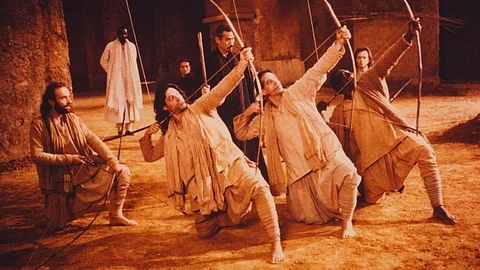
- HOMEGROWN WORLD
- #HGCREATORS
- #HGEXPLORE
- #HGVOICES
- #HGSHOP
- CAREERS
- ABOUT US
- CONTACT US

“It was a golden age. There was no war, no misery. Men were close to the gods.”
— Vyasa, Peter Brook’s The Mahabharata
A young boy enters a place. Is it a palace? A temple? Or a theatre? We do not know. But as he makes his way through this labyrinthine, maze-like structure, we get this feeling that he is also making his way through time. Concrete walls give way to stone; electric lights are replaced with oil lamps, made of earth and brass, placed on the floor and hanging from the unseen, unseeable above; there is a mask: the face of the elephant-headed god Ganesha; and there are heaps of bright red vermillion. Outside, in front of a fire, a man sits in meditation — his hair and beard unkempt, his face smeared with sacred ash.
“Do you know how to write?” the man asks the boy.
“No,” the boy answers. “Why?”
“I’ve composed a great poem, I’ve composed it all, but nothing is written. I need someone to write down what I know,” the man replies.
And so begins Peter Brook’s The Mahabharata — an adaptation of the ancient Indian epic unlike any other produced before or since.
Originally a 9-hour-long stage-play written by the French actor and writer Jean-Claude Carrière and directed by Brook, an abridged version was later filmed and edited into a 3-episode limited series for television and a 3-hour film for theatrical and DVD release. The landmark production brought together an ensemble cast of 21 actors from 16 different countries and musicians from Iran, Turkey, and Denmark to create a truly international production of the Mahabharata that spoke to the universality of the epic. First staged in the original French by Carrière in a quarry next to the Rhône outside the city of Avignon in France, the production toured the world for four years between 1985 and 1989.
Unfortunately, it was never allowed to be staged in India because of its radically essentialist interpretation of the Mahabharata. Stripped of all the pomp and campiness, and devoid of the faux gold and sequin glitz of usual Indian adaptations of the epic — often for television, and often from a devotional lens — Carrière and Brook’s adaptation focused on the humanistic heart of the Mahabharata mythology and condensed its mythic, superhuman characters into flawed human beings driven by greed, lust, and thirst for power, wealth, and legacy. Despite the high fantasy elements, the minimalistic but monumental set pieces alluding to the larger than life super-reality of the setting, and the deeply philosophical and metaphysical questions at the heart of the narrative, Carrière and Brook’s Mahabharata remained true to the post-modern realist traditions of Western literature, art, film, and theatre of the post-Vietnam war period.
I was still a teenager, sixteen or seventeen, when I first saw the 6-hour version of The Mahabharata in 2014. It was such a transformative experience for me. Although I had been familiar with the Mahabharata story — having read parts of the Sanskrit text as part of the mandatory Indian Culture curriculum for school, as well as R.K. Narayan's English translation and Gajendrakumar Mitra's Panchajanya, a Bengali retelling of the Mahabharata — Carrière and Brook’s version of the Mahabharata allowed me to see the epic in a new light, separate from the religious baggage it so often comes with in a hyper-religious country like India. Everything from the muted attires of the characters, to the contained, measured acting, the essentialist production design, and the understated, primitive visual effects allowed me to focus on the universal, humanist narrative at the heart of the epic.
Sadly, The Mahabharata disappeared from screens soon after its release. High quality prints were difficult to find, and this critically acclaimed, radical reimagination of this civilisational epic which positioned it as a universal story about the moral duties of men, about the balance of the universe, and the ambiguous nature of power and morality faded out of popular memory.
Now, 35 years after the film version of The Mahabharata originally debuted at the Venice Film Festival, an 8K version — meticulously restored by Brook's son Simon, also a film-maker — is returning to screens. The restoration was screened at the Venice Film Festival earlier this year and will release widely in 2025 — the centenary of Peter Brook's birth and the 40th anniversary of the landmark stage production.
If you enjoyed reading this, here's more from Homegrown:
18 Days Graphic Novel: Inspired By The Mahabharata
Raji, An Epic-Themed Indian Video Game With Stunning Visuals Is Taking Over The World By Storm
Giampaolo Tomassetti: Meet The Italian Artist Who Fell In Love With Indian Epics
